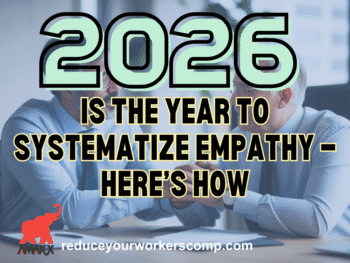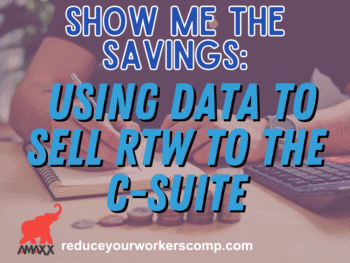
Work Injury: Time to Take Control
All employers and interested stakeholders need to have a post-injury response that ensures the needs of the employee are taken care of in an immediate manner. It also needs to go beyond ensuring a First-Aid kit is available and fully stocked.
- Ensure that all employees have the ability to call emergency services. Employer representatives also need to be available to ensure the emergency response teams are directed to the employee upon arrival;
- Respond to a work injury by ensuring that the accident scene is preserved. This includes ensuring that people who do not need access to the scene are denied entry; and
- Documentation of a work injury is important. Simple things like controlling spills, or ensuring other dangers are neutralized are key. Preserving physical evidence is also required.
Click Link to Access Free PDF Download
“9-Element Blueprint To Create Your Workers’ Comp Employee Brochure”
Once the injured employee is stabilized, other steps can be taken by employer representatives. It is important to have an appointed person from the employer to handle these actions to ensure information is properly given out. Steps that need to be taken include:
- Contacting the employee’s family or personal representative regarding the work injury;
- Meeting with the employee at the hospital or emergency room to ensure they are receiving appropriate medical care, and assist in making arrangements such as a car ride home; and
- Additional follow-up regarding workers’ compensation documents are filed. OSHA accident reporting may also need to take place.
Once the employee returns home, a follow-up telephone call or sending a “get better soon” card can buy goodwill.
Demystifying the Work Comp Process
The workers’ compensation claims process can raise many questions for an employee following a work injury. Interested stakeholders should make sure the employee understands the process and is provided with necessary information.
- Required documents related to the workers’ compensation case per state law. This generally includes a copy of the First Report of Injury, documentation regarding liability determinations, and basic materials regarding the workers’ compensation process;
- Basic claim information: name and contact information for the claim handler, claim number, and basics on submitting claim information; and
- Contact information for telephone numbers commonly used. This can include contact information for the state industrial commission, health care providers, and information regarding vocational rehabilitation assistance.
The workers’ compensation system is an adversarial process, and employees can get frustrated. Employers and other interested stakeholders can go the extra mile to provide general information and make the process easier to understand.
Implementing an Effective Post-Injury Response
Effective post-injury response requires a holistic approach on the part of the employer, insurance carrier, and how these two entities coordinate matters. Important issues that require these two parties to work together include:
- Identifying appropriate medical restrictions from the employee’s treating doctor. Employees are often confused as to what their restrictions on activity might be following a work injury. It is important to ensure the employee is providing copies of their relevant medical records regarding these restrictions to the claim handler and employer representative;
- Using nurse case management to coordinate the employee’s future medical care. Employees may often be confused as to what to do next. Using a nurse case manager can help avoid some of the uncertainty and better direct medical care;
- Communication with the employee regarding return-to-work matters. Getting employees back to work in any capacity will generally reduce the amount of money spent on a claim. It also helps the employee face the many challenges they fact following an injury; and
- Returning the employee to work in a light-duty position. Once an employee returns to work, it should be everyone’s priority to keeping them in the workplace. This includes crafting a suitable job offer that gives the employee meaningful work.
Using Injury Triage to Response
It is important that employers include an “injury triage” when responding to any work injury. When done correctly, more than 95% of injured employees will return to work with no or minimal lost time.
Injury triage is directing employees to the right level of care following a work injury. It starts by making sure the employee is aware of all employee’s preferred network providers. This will ensure the employer knows what medical facilities the employee receives care from near their location or job site. This is important as studies indicate that people are more willing to share information with health care providers they know and trust. In turn, this allows members of the claim management team to receive more accurate information regarding the mechanism of injury, and other vital information of an incident. The goal is to reduce excessive medical care and get the employee back to work.
Conclusions
Effective post-injury response requires engagement by all interested stakeholders. It goes beyond making sure an employee receives prompt medical care. Employer representatives and the claim team also need to engage and communicate with each other to make sure the claim is pointed in the right direction and can be resolved in a cost-effective manner.

Contact: mstack@reduceyourworkerscomp.com.
Workers’ Comp Roundup Blog: https://blog.reduceyourworkerscomp.com/
©2020 Amaxx LLC. All rights reserved under International Copyright Law.
Do not use this information without independent verification. All state laws vary. You should consult with your insurance broker, attorney, or qualified professional.
















